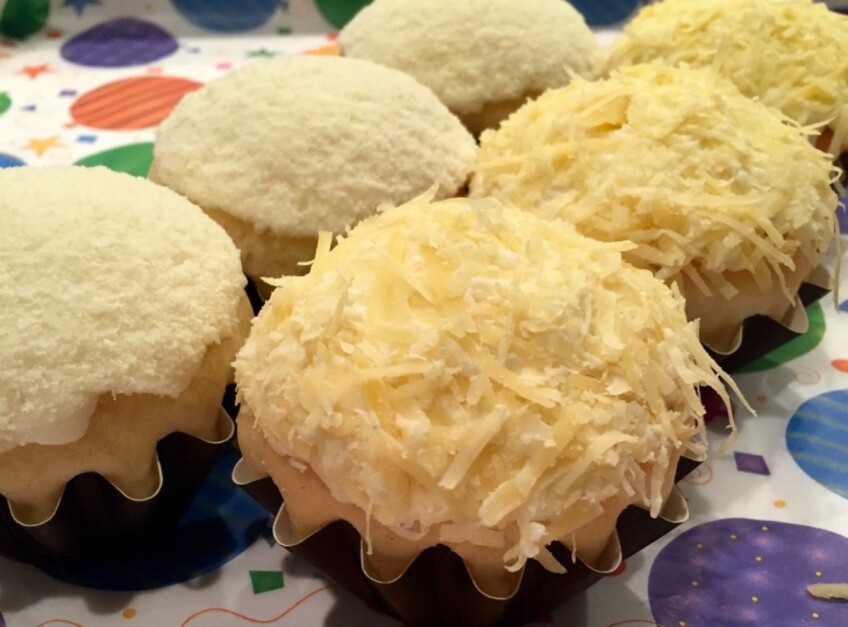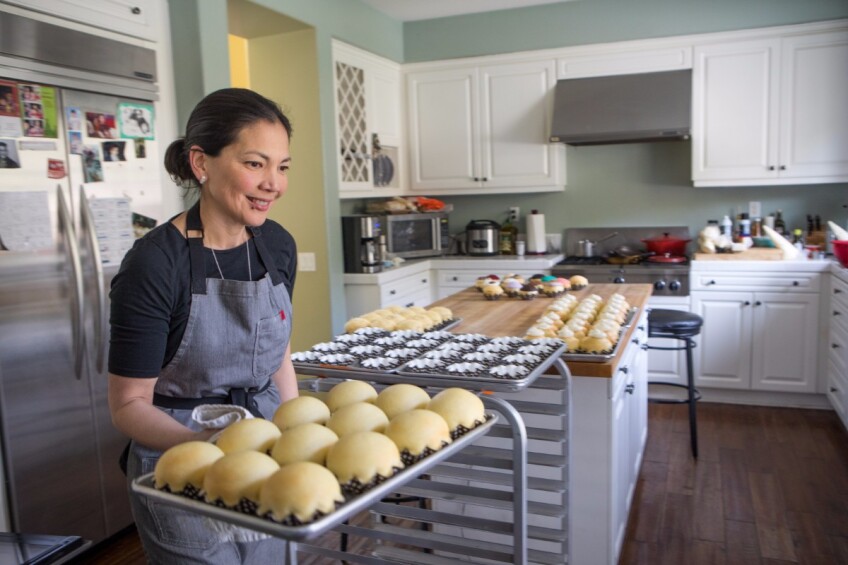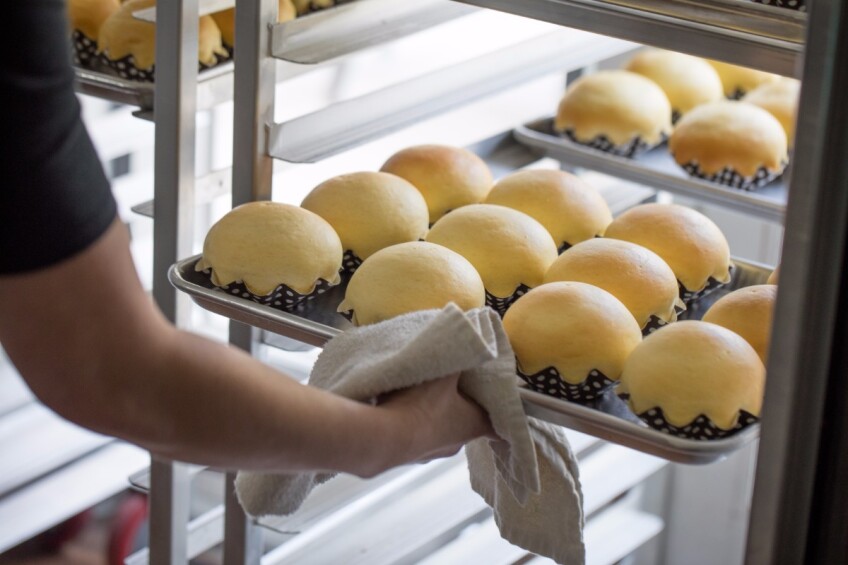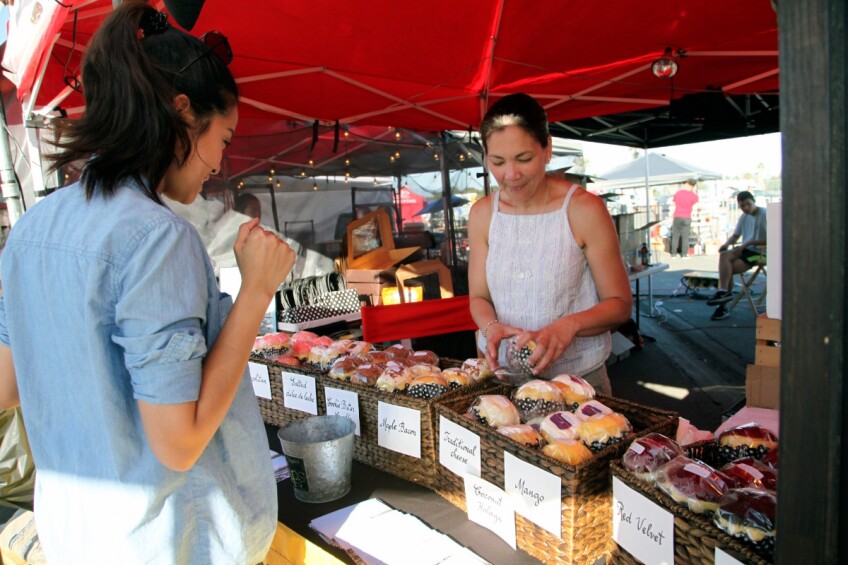Ensaymada Project Brings Sweet Filipino History and Flavors To Southern California


Standing underneath a vendor’s tent at a recent food festival in Orange County, Chari Heredia-Reyes smiles at potential customers who are peering into wicker baskets filled with dessert breads.
From far away, it looks like she’s selling giant cupcakes or muffins topped with icing. But when customers take a look closer, they learn that Heredia-Reyes is selling ensaymadas, handmade Filipino brioche bread made from yeast, butter and sugar, shaped into a coil, and traditionally topped with grated cheese. In addition, Heredia-Reyes has made some decidedly modern flavor tweaks to the traditional Filipino recipe, topping it with flavors like cookie butter, salted duck egg, or green tea and red bean.
Heredia-Reyes relishes this moment, when customers are giving the baked products a quizzical look and eventually ask the question she’s been waiting for, “What’s that?”

The 46-year-old businesswoman and mother-of-four who owns and operates the Ensaymada Project always has ready answers for their questions.
“I say Filipino brioche first, or straight up, it’s handmade bread,” Heredia-Reyes says about how she explains the ensaymada.
A teacher turned baker and entrepreneur, Heredia-Reyes has boundless energy when she’s interacting with her customers, punctuating her responses with, “Yup!” Heredia-Reyes says she has one goal in mind when it comes to her handcrafted goods — to elevate the ensaymada bread and make it as famous as any other dessert food out there.
“Why not?” she says. “[It’s] something to be proud of, there’s actually a product that can go up against the cupcake.”
Heredia-Reyes is doing her part to raise the profile of the dessert bread through her business, The Ensaymada Project, which she runs from her Canyon Country home.
She creates about 70 dozen ensaymadas per day. The process includes mixing yeast and milk then adding flour, egg yolks and butter. Heredia-Reyes says the mixture requires three sets of proofing, which allows the dough rise. The dough also needs to be pulled and stretched by hand before it gets flattened, rolled and shaped into a coil.
“There’s no shortcuts,” says Heredia-Reyes. “It takes the whole day. I took it from 14 hours and we were able to cut it to 10 [hours].”
Before creating the Ensaymada Project in 2009, Heredia-Reyes made the dessert bread as they are traditionally made in her home country of the Philippines, strictly during special occasions. She made them as gifts for family and friends during Christmas. Eventually, she started receiving orders from outside of her immediate circle and she realized, that she had a legitimate business.
Her ensaymadas were initially only sold through her website. Customers made their orders and Heredia-Reyes would ship the products to them. Later, Heredia-Reyes took the dessert bread to popular street fairs and events in the Los Angeles area.
At these food festivals, Heredia-Reyes says she educates attendees about the rich history of the ensaymada, which can be traced from Spain with influences from Arab culture. Ensaymada varieties can be found in Latin America and the Philippines.


Historians and culinary experts alike believe the Spanish bread, the ensaimada, originated from the Mallorca region in Spain, an island in the Mediterranean sea that was previously conquered by Moors, Muslim inhabitants in the region.
There are theories that the coiled shape of the bread imitates the turbans worn by the Moorish people. The Spanish later brought the ensaimada to its colonies in Latin America and the Philippines.
Filipino food writer Jenny Orillos says there are newspaper records from the 1800s showing how one bakery in the Philippine capital of Manila advertised ensaymadas that were “exactly the same as the best in Mallorca.”
The Mallorcan version is flakier and requires a recipe “with lard-less dough,” says Orrillos. Then lard is spread into the dough during the rolling and coiling process. Meanwhile, the Filipino version of the ensaymada became more like a brioche texture because egg yolk and butter is incorporated into the dough mixture.
“There is evidence that we used to make the ensaymada the Mallorcan way,” says Orillos. “But somewhere along the way, the ingredients and technique shifted into the brioche-style we know today, which is richer as it has butter in the dough and we use egg yolks. We have yet to trace when, how and why the shift happened.”
Orillos says the Filipino’s tender, buttery and rich ensaymada version is meant to be extravagant.
“It’s a bread we traditionally eat on special occasions only or give as gifts,” says Orillos. “If we have it for breakfast with native hot chocolate, it means it’s a Christmas morning or the eater just feels like indulging themselves that particular day.”
Orillos, who co-wrote the book “Panaderia: Philippine Bread, Biscuit and Bakery Traditions”, says local panaderias, or bakeries, around the Philippines also offer a less rich and cheaper version that consists of margarine and sugar.
Orillos says many bakers around the country today make their own interpretation of the dessert, creating new toppings or putting filling into the bread.
Heredia-Reyes’ recipe is taken from the traditional Filipino version. She learned how to cook the ensaymada from her mother when she was 20 years old. She was studying to become a doctor. But an awful chemistry teacher changed her plans. She said she quit her first semester and her mother did not want her to be idle around the house.
“So she taught me,” Heredia-Reyes says. “And I just remembered when I got older.”
Heredia-Reyes brings her own modern twist to the ensaymada through the toppings. The traditional ensaymada uses fine or grated cheese. But Heredia-Reyes says in order to reach customers outside of the Filipino market, she needed to incorporate other flavors. She now has nearly two dozen flavors including maple bacon, Nutella, and red velvet.
“It just works because I think the dough can handle both sweet, salty and savory,” says Heredia-Reyes.
She says the variations make the bread more attractive to customers outside of the Filipino community.

“We’re not in the Philippines, if we were in the Philippines, it would never cross my mind to introduce flavors because ensaymadas is already accepted as is, but it’s not here, so you kind of have to dress it up,” she says.
The Ensaymada Project is a family affair for Heredia-Reyes. At the Orange County food event, Heredia-Reyes brought with her 200 dozen ensaymadas per day. With that much product, her husband Ramon Reyes, a professional chef who studied at the Culinary Institute of America, and two of her children, were on hand to help.
The youngsters took turns helping customers. Heredia-Reyes says being at the food fairs is a great way to bond with her children.
“If you’re stuck in the office, and the children, you don’t even know where they are,” she says. “So that’s the thing about this. They’re right here with us. Even if it’s eight hours, you see them and you can still monitor them.”
Her kids also have other contributions, one — the 16-year-old — has mastered the art of wrapping the ensaymadas and lends advice when Heredia-Reyes comes up with names for new flavor toppings. Her 17-year-old daughter helps set up booths that Heredia-Reyes can’t attend herself.
Heredia-Reyes can count on fans of the Ensaymada Project to come out to food fairs and events. Arcie Cardona, a Midway City resident, has attended the Orange County Night Market for years and searches for the Ensaymada Project booth each time.
“I never knew what they were until I came here,” she says. “When you warm them up, when you taste them, the filling, it’s so gooey and they’re amazing.”


